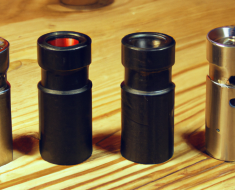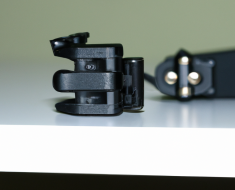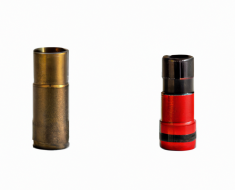“Precision shooting perfected with cutting-edge range finder technology.”
Benefits of Using Laser Range Finders for Precision Shooting
When it comes to precision shooting, having the right tools can make all the difference. One of the most important tools for any shooter is a reliable range finder. In recent years, advancements in technology have led to the development of laser range finders, which offer a number of benefits over traditional models.
One of the biggest advantages of using a laser range finder for precision shooting is its accuracy. Unlike traditional range finders, which rely on manual adjustments and calculations, laser range finders use advanced technology to provide precise distance measurements with the push of a button. This can be especially helpful when shooting at long distances or in challenging conditions, where even a small error in range estimation can have a significant impact on accuracy.
Another benefit of laser range finders is their speed and ease of use. With a traditional range finder, shooters often have to spend time adjusting settings and making calculations to determine the distance to their target. In contrast, a laser range finder can provide instant, accurate measurements with just a simple point and click. This can save valuable time in the field and allow shooters to focus on their shot placement rather than on calculating distances.
In addition to their accuracy and ease of use, laser range finders also offer a number of features that can help shooters improve their accuracy and precision. Many models come equipped with advanced targeting modes, such as scan mode, which allows shooters to track moving targets or multiple targets at once. Some models also offer angle compensation, which takes into account the angle of the shot to provide more accurate distance measurements.
Another useful feature of laser range finders is their ability to provide ballistic data, such as bullet drop and windage adjustments. By inputting information about their rifle and ammunition, shooters can use a laser range finder to calculate the exact holdover or adjustment needed to compensate for bullet drop or wind drift. This can be especially helpful when shooting at long distances or in windy conditions, where even small adjustments can make a big difference in shot placement.
Overall, the latest in range finder technology offers a number of benefits for precision shooting. From improved accuracy and ease of use to advanced features like ballistic data and targeting modes, laser range finders can help shooters take their accuracy and precision to the next level. Whether you’re a competitive shooter looking to improve your performance or a hunter looking to make ethical shots, a laser range finder can be a valuable tool in your arsenal. So why not take advantage of the latest in range finder technology and see how it can help you improve your shooting skills?
Comparison of Different Range Finder Technologies
When it comes to precision shooting, having the right tools can make all the difference. One of the most important tools for any shooter is a reliable range finder. Range finders help shooters accurately determine the distance to their target, allowing them to make more precise shots. With advancements in technology, range finders have become more sophisticated and accurate than ever before. In this article, we will compare different range finder technologies to help you choose the best one for your shooting needs.
One of the most common types of range finders is the laser range finder. These devices use a laser beam to measure the distance to a target by calculating the time it takes for the beam to bounce back. Laser range finders are known for their speed and accuracy, making them a popular choice among precision shooters. However, they can be affected by weather conditions such as rain or fog, which can interfere with the laser beam.
Another type of range finder technology is GPS range finders. These devices use GPS technology to determine the distance to a target by calculating the coordinates of both the shooter and the target. GPS range finders are not as fast or accurate as laser range finders, but they are not affected by weather conditions and can be used in any environment. They are also useful for determining the elevation changes between the shooter and the target, which can be crucial for long-range shooting.
Some range finders combine both laser and GPS technology to provide the best of both worlds. These hybrid range finders use GPS to determine the general distance to a target and then use a laser beam to fine-tune the measurement. This combination of technologies allows for fast and accurate distance measurements in any conditions. Hybrid range finders are often more expensive than single-technology range finders, but they can be worth the investment for serious shooters who demand the highest level of accuracy.
In recent years, there has been a rise in the popularity of rangefinder apps for smartphones. These apps use the phone’s camera and GPS technology to measure distances to targets. While smartphone apps are convenient and cost-effective, they are not as accurate or reliable as dedicated range finder devices. They can also be affected by factors such as poor lighting or shaky hands, which can lead to inaccurate measurements.
When choosing a range finder for precision shooting, it is important to consider factors such as accuracy, speed, reliability, and ease of use. Laser range finders are known for their speed and accuracy but can be affected by weather conditions. GPS range finders are not as fast or accurate but are not affected by weather and can be used in any environment. Hybrid range finders combine both technologies for the best of both worlds, while smartphone apps offer convenience but may lack accuracy and reliability.
Ultimately, the best range finder for you will depend on your shooting needs and preferences. Whether you choose a laser range finder, GPS range finder, hybrid range finder, or smartphone app, having a reliable distance measurement tool is essential for precision shooting. With the latest advancements in range finder technology, shooters can now make more accurate and precise shots than ever before.
How to Choose the Right Range Finder for Your Shooting Needs
When it comes to precision shooting, having the right tools can make all the difference in hitting your target with accuracy. One of the most important tools for any shooter is a range finder, which helps determine the distance between you and your target. With advancements in technology, range finders have become more sophisticated and accurate than ever before. In this article, we will explore the latest in range finder technology and provide tips on how to choose the right one for your shooting needs.
One of the key features to look for in a range finder is its maximum range capability. The maximum range refers to the farthest distance at which the range finder can accurately measure the distance to a target. For long-range shooting, it is essential to choose a range finder with a maximum range that exceeds the distance you plan to shoot. This will ensure that you can accurately measure the distance to your target, even at extended ranges.
Another important feature to consider is the magnification power of the range finder. Magnification allows you to zoom in on your target and make precise measurements. A range finder with higher magnification power will provide a clearer and more detailed view of your target, making it easier to accurately measure the distance. Look for a range finder with at least 6x magnification for optimal performance in precision shooting.
In addition to maximum range and magnification power, consider the accuracy of the range finder. Accuracy is crucial in precision shooting, as even a small error in distance measurement can result in missed shots. Look for a range finder with a high level of accuracy, typically measured in yards or meters. A range finder with an accuracy of +/- 1 yard or meter is ideal for most shooting applications.
Some range finders also come equipped with advanced features such as angle compensation and ballistic calculations. Angle compensation adjusts the distance measurement based on the angle of incline or decline to the target, providing a more accurate distance reading. Ballistic calculations take into account factors such as bullet drop and wind drift to help you make more precise shots. These advanced features can be especially useful for long-range shooting and hunting in challenging conditions.
When choosing a range finder, consider factors such as size, weight, and ease of use. A compact and lightweight range finder is easier to carry and handle in the field, making it more convenient for shooting on the go. Look for a range finder with a user-friendly interface and intuitive controls, so you can quickly and easily measure distances without any hassle.
In conclusion, the latest range finder technology offers shooters a wide range of features and capabilities to enhance their precision shooting skills. When choosing a range finder, consider factors such as maximum range, magnification power, accuracy, and advanced features like angle compensation and ballistic calculations. By selecting the right range finder for your shooting needs, you can improve your accuracy and hit your targets with confidence.
Advances in Range Finder Technology for Long Range Shooting
When it comes to precision shooting, having an accurate range finder is essential. The latest advancements in range finder technology have made it easier than ever to hit your target with pinpoint accuracy. Whether you are a seasoned long-range shooter or just getting started, these new features will take your shooting game to the next level.
One of the most exciting developments in range finder technology is the integration of laser rangefinders with ballistic calculators. This allows shooters to input variables such as wind speed, temperature, and bullet drop into the range finder, which then calculates the exact holdover or turret adjustment needed to hit the target. This eliminates the need for manual calculations and guesswork, making long-range shooting more precise and efficient.
Another innovative feature in modern range finders is the ability to connect to a smartphone or tablet via Bluetooth. This allows shooters to access detailed ballistics data, maps, and weather information right from their device. Some range finders even have the capability to sync with a smartwatch, providing real-time data and notifications while in the field. This level of connectivity and convenience is a game-changer for shooters looking to streamline their shooting process.
In addition to advanced ballistic calculators and connectivity features, the latest range finders also offer improved ranging capabilities. Many models now have extended range capabilities, allowing shooters to accurately range targets at distances of up to 2000 yards or more. This is particularly useful for long-range shooters who need to engage targets at extreme distances.
Some range finders also come equipped with angle compensation technology, which takes into account the angle of the shot when calculating the distance to the target. This is crucial for shooters who frequently shoot from elevated or downhill positions, as it ensures that the range finder provides an accurate distance regardless of the angle of the shot.
For shooters who prefer a more compact and lightweight option, there are now range finders available that are smaller and more portable than ever before. These pocket-sized devices are perfect for hunters and shooters on the go, allowing them to easily pack their range finder in a pocket or backpack without adding extra bulk.
Overall, the latest advancements in range finder technology have revolutionized the way shooters approach long-range shooting. With features such as integrated ballistic calculators, Bluetooth connectivity, extended range capabilities, angle compensation, and compact designs, shooters now have access to a wide range of tools to help them hit their targets with precision and confidence.
Whether you are a competitive shooter, a hunting enthusiast, or a recreational marksman, investing in a high-quality range finder with the latest technology is sure to enhance your shooting experience. So why wait? Upgrade your gear today and take your shooting game to the next level with the latest in range finder technology.
Tips and Tricks for Getting the Most Accurate Readings with Your Range Finder
Range finders have become an essential tool for precision shooting, allowing shooters to accurately measure distances to their targets with ease. With advancements in technology, range finders have become more sophisticated and accurate than ever before. In this article, we will explore the latest in range finder technology and provide some tips and tricks for getting the most accurate readings with your range finder.
One of the most exciting developments in range finder technology is the use of laser technology. Laser range finders use a laser beam to measure the distance to a target, providing incredibly precise readings. These range finders are capable of measuring distances up to several hundred yards with an accuracy of within a few inches. This level of precision is essential for long-range shooting, where even the smallest error in distance measurement can result in a missed shot.
Another important feature to look for in a range finder is angle compensation. When shooting at an elevated or downhill target, the angle of the shot can affect the distance to the target. Range finders with angle compensation technology take this into account and provide adjusted distance readings to compensate for the angle of the shot. This feature is particularly useful for hunters and competitive shooters who often find themselves shooting at targets on uneven terrain.
Some range finders also come equipped with ballistic calculators, which take into account factors such as bullet drop, wind speed, and temperature to provide accurate shooting solutions. These calculators can be a valuable tool for shooters looking to make long-range shots in challenging conditions. By inputting the relevant data into the range finder, shooters can quickly determine the correct holdover or windage adjustments needed to make an accurate shot.
When using a range finder, it is important to follow some basic tips to ensure you get the most accurate readings. First and foremost, make sure to properly calibrate your range finder before each use. This involves setting the range finder to the correct mode for your shooting conditions and ensuring that it is properly aligned with the target. Failure to calibrate your range finder can result in inaccurate readings and missed shots.
Additionally, it is important to practice using your range finder in a variety of shooting scenarios. By familiarizing yourself with how your range finder operates in different conditions, you can improve your accuracy and confidence when shooting in the field. Take the time to experiment with different settings and features on your range finder to see what works best for you.
Finally, always remember to take into account any environmental factors that may affect your range finder’s performance. Bright sunlight, fog, rain, and other weather conditions can impact the accuracy of your range finder readings. Be aware of these factors and make adjustments as needed to ensure you are getting the most accurate readings possible.
In conclusion, range finder technology has come a long way in recent years, providing shooters with the tools they need to make accurate shots at long distances. By investing in a quality range finder with advanced features such as laser technology, angle compensation, and ballistic calculators, you can improve your shooting accuracy and confidence. Remember to follow the tips and tricks outlined in this article to get the most out of your range finder and take your shooting skills to the next level.






